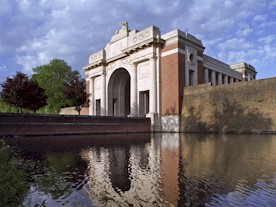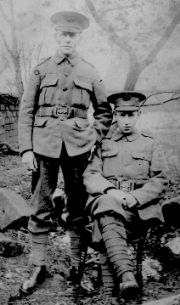|
|
| Home Topics Memorials Miscellany Transcripts References Family History Glossary Latest Beeston Blog About us | Site Search |
|
But, as it did for families throughout the land, everything changed when War came in August 1914. The two brothers were quick to respond to the call, presenting themselves at the Recruiting Office in Nottingham on 5 December 1914. They both enlisted with the Kings Royal Rifle Corps - with sequential service numbers, 8001 and 8002. It is known that William Hugh was identified during the enlistment process as suitable for advancement within the Regiment, as his recruitment papers were annotated 'smart lad, respectable appearance' who 'will develop to standard'4. He was never to have that chance. The brothers - shown in the photograph in the early days of their service, with William Hugh on the right - both joined 7th (Service) Battalion, part of 41st Brigade in 14th (Light) Division, for basic training at Grayshott in Hampshire where they were billeted in the school and village hall, moving to more suitable accommodation at the nearby Bordon Army training camp before a final move to Aldershot in March 1915. By May 1915, the recruits were considered to be ready for action - despite lacking equipment - and left from Folkstone on 19th May 1915, landing at Boulogne late that day. Their move to the fighting front was delayed slightly by a lack of rifles and ammunition but, by 28th May, 7th Battalion had arrived in Ouderdom where they were billeted in huts to the rear of the Ypres salient while the men received eight days training in trench warfare. Over the next few weeks the Battalion was involved in active trench warfare during which it received many casualties and experienced gas attacks5. On 22th July the Battalion moved to Hooge, about four kilometres to the east of Ypres where, three days earlier, a mine had been succesfully detonated beneath the enemy, creating a hugh crater and much disruption of the enemy lines. However, the enemy hit back hard and there were many casualties. It was then that the enemy used flamethrowers for the first time, which terrified the men greatly. Though not aimed directly at 7th Battalion, the wall of flame and clouds of smoke did affect its position near the strategically important Hooge Chateau stables. Heavy attacks by the enemy, were met by counter-attacks by 7th Battalion and others which were largely unsuccessful and, although the line was held, the Chateau and crater fell into the hands of the enemy. It was during this fighting, on the 30th July, that Rifleman William Hugh Thornhill was found to be missing, one of many from the fighting that had been faced during that month. His body was never identified and he remained officially 'Missing' until 16 May 1916 when an Army Council decided that he was to be regarded as deceased since 30 July 19156. He is remembered on the Menin Gate Memorial to those killed in the Ypres Salient, with no known grave. For the family, there remained the undoubted ordeal of receiving his back pay (£7 4 10d) and Gratuity of £3 and, after the war, his medals, the British & Victory Medals as well as the 1914/15 Star. His brother Isaac, who was fighting beside him during this time, survived this battle and continued fighting with the Battalion for more than a year, until he was badly wounded on 2nd September 1916, resulting in him being invalided out of the Army7 to survive and to continue as normal a life after the War as was possible. He married twice, firstly to Hilda Irene (née Seppings) who died young when their only child was aged one, and then to Constance Cragg and had a further two children. He died in 1973. Footnotes 1The photograph of the Menin Gate is from the Commonwealth War Graves Commission website. (http://www.cwgc.org) 2Recorded in the Thornhill family Bible, seen by David Hallam during an interview with Emily May (née Thornhill) Cragg. For some unexplained reason, he was baptised at Bramcote Church on 9 January 1898 (Notts Family History Society index) 3In 1911, the family (other than the two sons who where boarding at Ockbrook School) were at 55-57 High Road, Beeston, Notts, where three generations of the Thornhill family had operated as gentlemen's tailors. They employed a domestic servant. (1911 Census - Piece 20426 RD429 SD 3 ED 1 Shed 202). There is more comprehensive story of the Thornhill family elsewhere on this site 4Information from the surviving Army Service Record for William Hugh Thornill. His brother Isaac's record does not survive but it is likely that he was similarly recommended for advancement. 5We have drawn on the Battalion's War Diaries (on ancestry.com) for much of the detail of the Battalion's movements. 6Noted in his Army Service Record. His name is not amongst the many listed on the Battalion War Diary as killed, wounded or missing. As this was written in the field under difficult conditions, it is perhaps not surprising that there were ommissions in the list. Although his age is recorded as 19 in the Commonweath War Graves Commission records and he declared his age as 19 years 2 months when he enlisted, he was not yet 18 at the date of his death. 7Isaac was issued with a Silver War Badge, worn as a civilian to indicate that he had served, on 13 January 1917 (Register of Issued Badges on ancestry.com) |
|
||||||||||||
|
|
||||||||||||||


 William Hugh William was born on 5 October 18972, the second of the two sons, four children, of Isaac and Emily Hinde Hutchinson (née Barnes) Thornhill. Isaac
(1861-1940), was the second son of William and Eliza (née Wibberley) Thornhill, and was the latest of three generations of the Thornhill family to operate as tailors at 55/57 High Road
in Beeston. By the time that war was declared William Hugh and his brother Isaac junior (1895-1973) had already begun to learn the trade. Both had received an excellent education at the well regarded
Moravian School in Ockbrook, Derbyshire and the two brothers were very close and sang in the Beeston Parish Church choir together. This close-knit and well-established family was completed by two younger
sisters, Emily May Thornhill (1900-1984) and Constance Barnes Thornhill (1902-1974)3.
William Hugh William was born on 5 October 18972, the second of the two sons, four children, of Isaac and Emily Hinde Hutchinson (née Barnes) Thornhill. Isaac
(1861-1940), was the second son of William and Eliza (née Wibberley) Thornhill, and was the latest of three generations of the Thornhill family to operate as tailors at 55/57 High Road
in Beeston. By the time that war was declared William Hugh and his brother Isaac junior (1895-1973) had already begun to learn the trade. Both had received an excellent education at the well regarded
Moravian School in Ockbrook, Derbyshire and the two brothers were very close and sang in the Beeston Parish Church choir together. This close-knit and well-established family was completed by two younger
sisters, Emily May Thornhill (1900-1984) and Constance Barnes Thornhill (1902-1974)3.